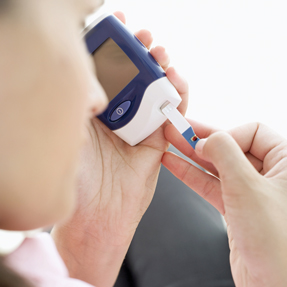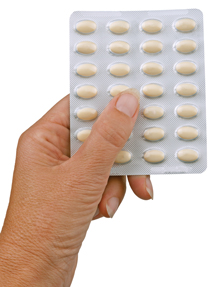Teaching diabetes self-management ‘basic survival skills'
Diabetes self-management education is cost-efficient and can improve A1c levels “far greater” than the effect required to approve a new drug for the disease. Smartphones, health coaches and educators are part of the new paradigm to help patients.
There's a cost-efficient, effective treatment for diabetes that is significantly underused in the United States today, both in and outside of the hospital.
“We know that it can dramatically improve hemoglobin A1c. In fact, the reduction shown in meta-analysis is far greater than what's required to approve a drug by the FDA,” endocrinologist and ACP Member Robert Gabbay, MD, PhD, told attendees at the American Diabetes Association (ADA) annual meeting, held in Philadelphia in June.

Dr. Gabbay, who is director of the Penn State Hershey Diabetes Institute in Pennsylvania, was talking about diabetes self-management education, an intervention that can range from the basics of how to test blood sugar to assistance with reshaping a whole diet and lifestyle.
Teaching diabetes on the phone
A room, a desk, a book—these are the typical tools of education. But the latest in diabetes self-management education requires none of these accoutrements.
“Cell phones are emerging as a fantastic platform for personal health and wellness applications,” Lena Mamykina, PhD, assistant professor of biomedical informatics at Columbia University in New York, told American Diabetes Association meeting attendees.
To help manage diabetes, today's smartphones can keep records (of blood glucose measurements or food consumed, for example) input by the patient, or even track data on their own, such as sensing movement when a person is exercising. They can also provide social support and communication.
The last of these was the focus of a recent study led by Dr. Mamykina. A group of diabetic patients under age 65 were enrolled in in-person diabetes education classes and given smartphones. Using the phones, they were encouraged to send data frequently to a diabetes educator, including blood glucose results (measured and transmitted via a Bluetooth attachment) and meals (photographed or described in e-mail or voice notes).
The educator remotely provided advice to the patients, on what might be a good choice for breakfast, for example, and answered specific questions. After five months, the researchers compared the smartphone patients to a group that had received only the diabetes education classes.
The smartphone group was significantly more likely to think that diabetes was theirs to control (as opposed to having an external locus of control). “When they had a chance to very clearly see how their behaviors impact their glucose readings, it put them more in a position of asserting themselves and taking responsibility,” said Dr. Mamykina. “Interestingly, the quality of life [for those patients] went down...The fact that you are in charge of your health is not always a very positive discovery.”
More positively, researchers also discovered that the interactions between patients and educators fit into a pattern of problem-solving and coaching. Much of this work could potentially be handled by an automated system instead of a trained educator, Dr. Mamykina hypothesized. “What we're hoping to do is replicate the same process just with our application, without an educator,” she said. A trial of this “mobile diabetes detective” will begin next year.
However, some of the study's participants might not be comfortable with such a system. Although no one over 65 was included in the study, some still reported discomfort with the provided smartphone. “I was really afraid I would break something,” one patient said.
Such patients might be better suited to a lower-tech program such as that instituted by the University of California, San Francisco (UCSF). Researchers there developed a program for mostly non-English-speaking patients of several safety net clinics who had poorly controlled diabetes. Patients didn't even have to have a cell phone to participate; a landline would do.
“You receive a weekly call which has some automated questions,” explained Margaret Handley, PhD, MPH, an associate professor of epidemiology and biostatistics at UCSF. “It'll ask you questions like, ‘How many days in the last seven days have you checked your blood sugar?’”
Based on patients' responses, the phone system might play a prerecorded narrative in their native languages. “Something like ‘Your problem sounds like what Mrs. Jones was experiencing when she forgets to take her diabetes medicines. She came up with a strategy to help her remember’ and we give an example. We worked a lot with patients to come up with those narratives,” said Dr. Handley.
If a patient's responses are significantly out of line with her goals (for example, missing doses on three or more days), a health coach would call the patient within 24 hours. “The [health coach's] discussion really focused on action plans and motivational interviewing and a lot of times didn't really even address that particular trigger directly. Most patients had several triggers and the conversation might flow to what were the challenges in that week,” Dr. Handley said.
The program resulted in improved satisfaction, communication, functional status and even exercise among the involved patients, as well as other benefits. “We came across a lot of potential adverse events, particularly among patient who didn't have good English skills,” she said. The health coaches noticed misunderstandings of medication regimens, for example.
The program was also found to be so cost-effective that the local Medicaid provider adopted it. Most of the participants in that follow-up program spoke Spanish or Cantonese, and overall, their physical quality of life significantly improved on the program. “Clinicians were extremely satisfied that there was now something they could offer patients to receive extra care in their language,” said Dr. Handley.
One challenge found in the latter study, and likely to arise in other real-world applications, was that the health coaches, call-center workers with no prior health care training, didn't stay in the job long. “It was a young population with a lot of turnover. We were doing a lot of training,” said Dr. Handley.
Based on the results of the final trial described at the ADA meeting, she might want to try hiring educators with more specialized training. Pennsylvania researchers conducted the first comparative effectiveness trial of different diabetes self-management support strategies.
Patients in the trial received phone calls from one of three sources, depending on which group they were randomized to: a peer with diabetes, a certified diabetes educator, or any staff member from a primary care physician's office. At three and six months, the groups were compared to each other, and a usual care group, on hemoglobin A1c, diabetes empowerment, quality of life and self-care activities.
“It was clear that patients who received follow-up support from a diabetes educator did the best,” Dr. Gabbay said. “Diabetes educators may be best suited to provide ongoing self-management support,” he concluded, to applause from the audience of diabetes experts.
Inpatient educators
Other speakers at the ADA meeting noted existing obstacles to diabetes education, particularly in hospitals, but described innovative strategies they have applied to teach patients these necessary skills.
“The inpatient setting is not the ideal setting for diabetes education,” said Amy Donihi, PharmD, an associate professor and clinical pharmacy specialist at University of Pittsburgh Medical Center (UPMC) in Pennsylvania.
Inpatient education efforts are limited by severity of illness, lean staffing, time shortages and failures of planning, she added. “I can't tell you how many times I'll get a call from a frantic nurse saying, ‘I'm so sorry for the late notice, but Mr. So-and-so is going home today and we just realized he's moved to insulin. Can you please come teach him about his insulin pen?’”
However difficult it may be, inpatient education appears to be important to long-term patient outcomes. When Dr. Donihi's hospital, UPMC Presbyterian, lost its only full-time diabetes educator, negative consequences were seen.
“We heard some anecdotal reports from some of the outpatient educators, ‘The patient came to me a month after hospital discharge and didn't take any of their insulin because nobody taught them how to use their insulin prior to discharge.’ We heard some anecdotal reports that people were being readmitted because there was a gap between discharge and the first primary care visit,” she said.
Improving those results doesn't require teaching patients everything about diabetes. “By the time patients leave the hospital, they need to have a basic understanding of how to take care of themselves and their diabetes,” Dr. Donihi said. “These basic survival skills should include the ability to perform home glucose monitoring and understand the results at a basic level, the ability to detect and prevent hypoglycemia, the ability to understand basic meal planning, the ability to take medications accurately and safely, and safe use and disposal of needles and syringes.”
Without an organized diabetes education program at UPMC, these skills were sometimes neglected in favor of other, less urgent ones. “We would hear the nurse say, ‘I had a great discussion with this patient on foot care.’ Is that really important to talk to them about before they go home?” said Dr. Donihi.
To remedy this problem, and other shortcomings in diabetes education, a committee at UPMC developed a process, involving nurses, dietitians and pharmacists, for every diabetic inpatient. Under the new system, the primary nurse care coordinator of the patient's unit (who functions like a charge nurse) uses the electronic health record to identify patients with diabetes on their problem lists. She provides them with a diabetes toolkit (a book and DVD), gives them a blood glucose meter if necessary, and coordinates an appointment with an outpatient educator within 72 hours of discharge.
The bedside nurse also has a role in the system. “We couldn't add too many more responsibilities to her job, but we really focus on telling her to reinforce teaching for all of her assigned patients,” said Dr. Donihi. “Teach the patient while she's in there. Have the patient watch the 7 a.m. insulin dose, and then for the pre-lunch dose, have the patient actually demonstrate how to do it.”
The hospital dietitian sees any patient who has been newly diagnosed, has an A1c over 8%, or was admitted due to diabetes. The pharmacist sees any new diagnoses and patients being started on insulin or an oral medication for the first time.
To measure the effects of this new, organized system, UPMC surveyed patients after discharge. “About 64% remember being taught. All the patients who were new to insulin did remember being taught,” reported Dr. Donihi. More than two-thirds could name the insulin they were taking, and 84% could describe hypoglycemia symptoms. “Most patients had some knowledge regarding their insulin regimen,” she said. “We're going to use these results to improve our process.”
The results do prove that inpatient, team-based education is feasible, though. “In the absence of a diabetes educator, the responsibility for diabetes education can be shared among the various disciplines,” Dr. Donihi said.
Insulin instruction
When Massachusetts General Hospital (MGH) in Boston set out to improve diabetes education, they also started with a team. This one included an endocrinologist, a certified diabetes educator and a nurse practitioner. The target patient population for their project was narrower—patients with high A1cs who were admitted to the hospital for reasons other than uncontrolled diabetes.
The team evaluated the patients and then provided them with individualized diabetes education and discharge preparation (including instructing them about medication and communicating with primary care physicians). If the patients weren't already on insulin, it was initiated.
The insulin, along with short lengths of stay and high severity of illness, was a reason that the trial had trouble recruiting many patients; only 31 were enrolled after thousands were screened. “While most of them were eligible for insulin initiation, unless somebody came in and said, ‘It's time for you to start insulin,’ it was not something they wanted to do at that moment,” said endocrinologist Deborah Wexler, MD, assistant professor at MGH.
The education involved insulin instruction and whatever else patients were ready to learn. “We took patients where they were and tried to get them to the next level,” Dr. Wexler said. When the patients were followed for a year after discharge, the results showed that those who were newly introduced to insulin had reached a new level of success. “In insulin-naïve, we did have a one-year decrease in A1c of 1%, compared to no change or worsening in the usual care group,” she said.
There were no significant changes in the patients already on insulin, but the study did provide some additional lessons. “The inpatient setting is a very high-yield time to identify high-risk patients. Intervention and education are challenging and connection to outpatient care at discharge is absolutely key,” concluded Dr. Wexler.
Managing the transition
The University of Pennsylvania's Care Transitions program targets precisely those issues, for patients with diabetes and others at high risk of returning to the hospital soon after discharge. Brian Bixby, CRNP, told ADA attendees about the program.
“Typically, our patient is the person with heart failure, COPD, diabetes,” he said. Each patient is matched with a nurse practitioner who sees him during hospitalization and then visits his home after discharge. “We will see them for six to eight weeks, eight to ten visits at home and also [go] to any follow-up visits that they have,” Mr. Bixby said. Tagging along on outpatient visits, the nurse provides an extra set of ears and a copy of inpatient records, he noted.
The program has been effective in decreasing readmissions and lowering overall health care costs, even considering the cost of the nurse practitioner's time. “The nice thing about being in the home for the six weeks is it gives them enough time to get into trouble, recognize it and work with you to develop a better plan,” he said.
The planning may include medication changes or scheduling of routine follow-up care. The visits may also allow a nurse to recognize potential trouble before a patient would. Mr. Bixby recently treated a patient who had been diagnosed with diabetes in the hospital, and during follow-up, the patient developed an abscess and a fever at a time when a primary care physician was unavailable, so he sent him to the emergency department.
Right now, these services are only available to some Pennsylvania patients covered by Independence Blue Cross or Aetna, but there's potential that the program will expand to help other patients improve their self-care after hospitalization, according to Mr. Bixby. “They will be educated based on their goals and be able to move forward and perform self-management,” he said.




